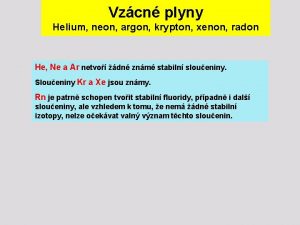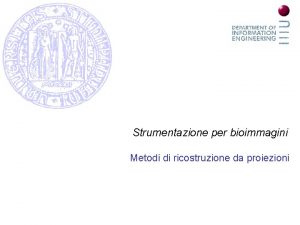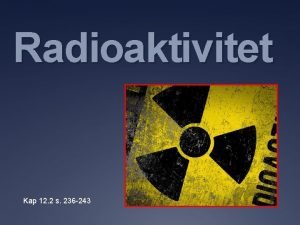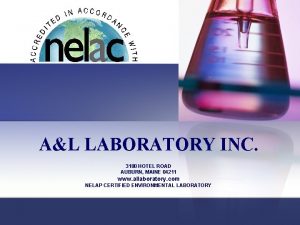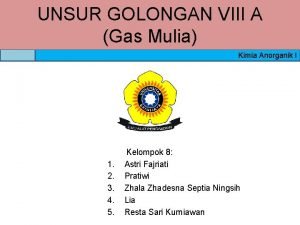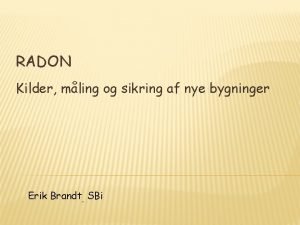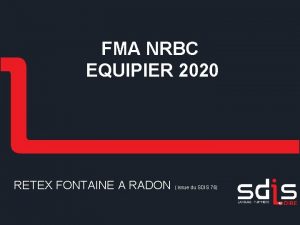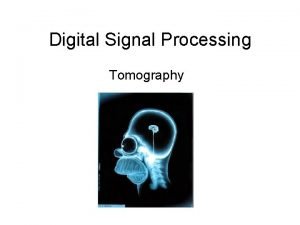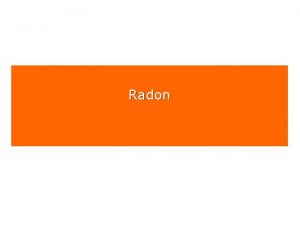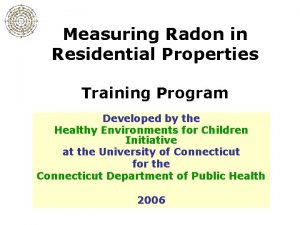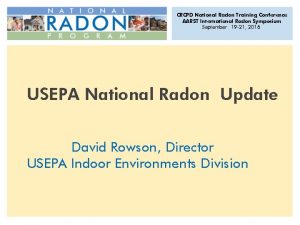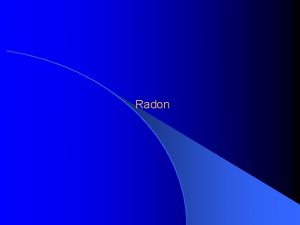Measuring Radon in Residential Properties Training Program Developed














- Slides: 14

Measuring Radon in Residential Properties Training Program Developed by the Healthy Environments for Children Initiative at the University of Connecticut for the Connecticut Department of Public Health 2006

Lesson 1 What is radon?

Characteristics of radon • Gas • Colorless • Odorless • Tasteless • Occurs in nature • Radioactive • Harmful to human health 2

Simple atom • Nucleus – Protons (+ or positive charge) – Neutrons (no charge) • Electrons (- or negative charge) 3

Radon (Rn) atom Atomic number = Number of protons 86 Atomic mass or mass number = Number of protons + number of neutrons Varies 4

Naturally occurring radon isotopes Number of protons Number of neutrons Atomic mass Radon-219 86 133 219 Radon-220 86 134 220 Radon-222 86 136 222 5

Isotopes • May be stable or unstable • Unstable isotopes (radioactive) decay spontaneously (change to another element) called – Decay products – Progeny – Daughters • During decay, unstable isotopes give off radiation Radiation = energy emitted as invisible • Particles • Waves • Rays 6

Radon decay series Radon-222 Polonium-218 Lead-214 Bismuth-214 Polonium-214 Lead-210 7

Radon and its decay products Radon Decay products Gas Solid Chemically inactive Chemically active No static electrical charge Electrically charged Primary source of cell damage leading to lung cancer 8

Types of radiation released Alpha ( ) Beta ( ) Gamma ( ) Relatively large mass Relatively small mass No mass = 2 protons and 2 neutrons = 1 electron = pure energy (electromagnetic radiation) Electrical charge of +2 Electrical charge of -1 No electrical charge Moves slowly Moves quickly Moves at the speed of light Least penetrating Moderately penetrating Most damaging to human health 9

Radiation released in radon decay Radon-222 + Polonium-218 + Lead-214 + Bismuth-214 + Polonium-214 Lead-210 + 10

Example of half-life 11

Half-lives of radon and its decay products Radon-222 3. 8 days Polonium-218 Lead-214 3. 1 minutes 26. 8 minutes Bismuth-214 19. 7 minutes Polonium-214 Lead-210 160 microseconds 22. 6 years 12

Summary Radon is an element with these characteristics • • No No color • smell • taste • electrical charge • • Gas Radioactive Naturally occurring Inert Harmful to human health 13
 Pinewood bowmanville
Pinewood bowmanville 5 rules of rational thinking rdap
5 rules of rational thinking rdap What are the disadvantages of circuit training
What are the disadvantages of circuit training Helium neon argon krypton xenon
Helium neon argon krypton xenon Trasformata di radon
Trasformata di radon Retroproiezione tac
Retroproiezione tac Multifamily radon testing
Multifamily radon testing Vem upptäckte radioaktiviteten
Vem upptäckte radioaktiviteten Radon map maine
Radon map maine Sifat xenon
Sifat xenon Studsfuge ventilation
Studsfuge ventilation Washington state radon map
Washington state radon map Gazy szlachetne zastosowanie
Gazy szlachetne zastosowanie Radon
Radon Radon transform
Radon transform



